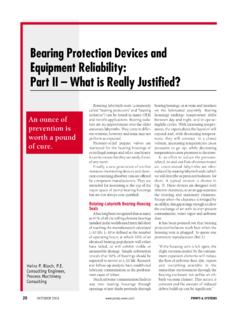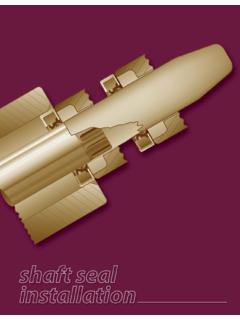Transcription of Using Belleville To Maintain Bolt Preload - GPI
1 Using Belleville Springs To Maintain bolt Preload George P. Davet, Solon Mfg. Co. TABLE OF CONTENTS. 1. INTRODUCTION. What is a Belleville Spring? 2. PRINCIPLES OF Belleville SPRINGS. Why Does a bolt Loosen? The Joint Diagram Using Belleville Springs to Maintain bolt Preload Movement in Flanged Joints Bus Conductors and Differential Thermal Expansion 3. TESTING. Test of Bellevilles Used on a Bolted Joint Tests of Bellevilles Used on a Flanged Joint Conclusions of Flange Tests 4. Belleville SPRINGS IN PRACTICE. Designing a Live Loaded Joint System A Practice Problem 5. REFERENCES. 1. INTRODUCTION. What is a Belleville Spring? A Belleville Spring is a conical shaped disc that will deflect (flatten) at a given spring rate when subjected to an axial load Fp (Figure 1).
2 This rate is usually very high relative to a coil spring, which makes a Belleville an excellent candidate where large loads must be delivered through a short movement. Some applications where Bellevilles are commonly found are: clutch and brake mechanisms in heavy equipment, punch and die sets, bearing assemblies, switchgear, and anywhere bolt pre-load must be maintained over time. A Belleville Spring's geometry can be characterized by four dimensions: OD. OD = outside diameter Fp ID. Fp ID = inside diameter t = material thickness H Fp h Fp h = deflection-to-flat t Figure 1 A section of a Belleville Spring showing load Fp applied at the "upper-inside" and "lower- outside" corners.
3 Some manufacturers use the parameter H (free height t+h) in lieu of h. In a bolted joint the spring is normally loaded at the upper-inside edge by the nut or bolt head and the lower-outside edge by the joint. Manufacturers also use a parameter called "flat-load" or "load-to-flat" (F W) in their description of a Belleville Spring. This is the force required to "push" the spring into the flat position. As the nut in a bolted joint is torqued the spring starts to deflect (flatten) and the bolt begins to stretch. The Belleville will be in its flat position when the Preload in the bolt equals the flat-load1 Since the spring will be clamped between the flat joint and the nut, any additional torque applied to the nut will only stretch the bolt .
4 Higher loads (than F W) will normally not damage the spring if the load cannot deflect it past the flat position (as in most bolting applications). Therefore, the maximum force that can be applied to a Belleville mainly depends on the limitations of the bolt or joint designs. The spring rate of a Belleville depends on geometry, material, and loading conditions. A. plot of load versus deflection will show that the Belleville 's characteristic curve is linear up to about 90% of the flat After 90% the load increases progressively because the spring begins to bottom out. Figure 2 shows a typical load deflection curve of a single Belleville . Note that for a given deflection the decreasing loads are lower than those on increasing.
5 This hysteresis is caused by the friction between the spring and the loading surfaces. 1. This applies to most Bellevilles that are used in bolting applications; however, springs can be designed to have a non-linear characteristic curve. The load/deflection relationship can be 5. altered by Using multiple springs in series or parallel or a combination of 4. both (Figure 3). Bellevilles are said to be in series when the concave and convex surfaces alternate the direction 3. Thousands LOAD. they are facing [1]. In other words, they are stacked "cup to cup" and "crown to 2. crown." Springs stacked in parallel face the same direction. The convex side of 1. one spring is "nested" into the concave surface of the next.
6 Bellevilles may also be arranged in "series-parallel" by 0. 0 alternating sets of springs stacked in INCHES. DEFLECTION. parallel. Figure 2 Load deflection curve for a single Belleville Spring. The upper curve represents and increasing load while the Two springs stacked in parallel doubles lower curve shows the spring unloading. the load required to flatten the springs with no increase in deflection. Two Bellevilles stacked in series will produce SINGLE Belleville TWO IN SERIES. twice the deflection for the same load. Figure FLAT LOAD = 1 X Fw DEFLECTION = 1 X h FLAT LOAD = 1 X Fw DEFLECTION = 2 X h 4 shows the load deflection curves for various combinations of springs. The frictional hysteresis increases as more springs are used in parallel because the larger contact areas result in higher frictional forces.
7 These forces are decreased as more washers are TWO IN PARRALLEL. FLAT LOAD = 2 X Fw SERIES-PARALLEL. FLAT LOAD = 2 X Fw DEFLECTION = 1 X h DEFLECTION = 2 X h used in series since some of the contact surfaces will "roll" rather than "slide." Figure 3 Flat load, deflection, or both may be altered 2. PRINCIPLES OF Belleville by stacking Belleville Springs in various arrangements. Thousands Load (#'s). Figure 4 Load deflection curves of several different Belleville arrangements. This shows that adding springs in series increases deflection without increasing load, while Using springs in parallel multiplies SPRINGS. Why Does a bolt Loosen? After a bolted joint is assembled, some of the original Preload is almost always lost.
8 This happens because the components of the joint immediately begin to relax and move. If the joint is a flange with a gasket, the losses become more severe over time. This is especially true if it is subjected to wide temperature cycles. Some of the phenomena that cause Preload to be lost at assembly and over time are briefly described below: 1. Embedment Relaxation. When new studs and nuts are tightened onto the joint, the components contact each other only on microscopic high spots. Since these high spots will be overloaded, they will yield. As this yielding occurs the bolts will relax and the contact area will increase. It is estimated that when the system finally stabilizes that as much as 5- 10% of Preload may be lost to embedment relaxation.
9 2. Gasket Creep. Gaskets are designed to creep and flow into the crevices of the joint surfaces when subjected to high surface loads. This is absolutely necessary to ensure performance. As plastic flow occurs the flange faces will come closer together slightly. This results in some loss of Preload . The amount that is lost is primarily a function of the gasket material and design. Tests sponsored by the Subcommittee on Bolted Flange Connections of the PVRC reveal that creep in some spiral wound gaskets only account for a 2-5% loss in Preload at room temperature. For PTFE based gaskets this value can be higher. Increased temperature will also cause gaskets to creep but the effect on Preload varies from gasket to gasket.
10 3. bolt Creep. Bolts used in high temperature service will tend to relax over time. The amount of Preload lost depends on the bolt material, temperature, and length of time at temperature. 4. Vibration. Under severe vibration fasteners will lose Preload very slowly at first. When the tension falls below a critical value, the rate of relaxation increases as the surfaces between the male and female threads begin to slip. 5. Elastic Interactions. This phenomena can be avoided if all of the bolts in a joint are tightened simultaneously. In the real world, however, this rarely happens. On flanged joints, for instance, the bolts are tightened in stages Using a crossing pattern. The first pass is tightened to approximately 30% of the final desired Preload .













